The Philadelphia 76ers have to have a plan for Al Horford.
Few individual transactions in recent history have been more catastrophic than the Philadelphia 76ers’ decision to sign Al Horford to a four-year, $109 million contract. That deal, of course, coincided with the departure of Jimmy Butler, who the Sixers never properly appreciated.
In 67 regular season games, Horford averaged 11.9 points and 6.8 rebounds on 45 percent shooting. That’s his lowest scoring mark since 2008-09, and the lowest shooting percentage of his career. Even his rebounding numbers tied a career low. It was a grim season for the 34-year-old.
While Horford isn’t entirely washed — he still had his brief (very brief) moments last season — it’s fair to proceed with complete skepticism when it comes to his future in Philadelphia. While the Sixers are expected to pursue trades this offseason, nothing is guaranteed. The Sixers have to be prepared for Horford to be on the roster next season.
More from Sixers News
- 3 Sixers players who could help Team USA Basketball
- 76ers 2k24 ratings: 3 most underrated players on Philadelphia roster
- 76ers head coach Nick Nurse bares lofty plans for Paul Reed this season
- Grade the Trade: 76ers swap Tobias Harris for superstar PG in mock deal
- Breaking Down Bombshell Report on Sixers Star James Harden
If Horford is indeed on the roster when the season begins, his role will pose one of Doc Rivers’ biggest challenges as head coach. One could argue Brett Brown’s inability to mine positive value from Horford was the leading cause behind his dismissal. Rivers will need to keep Horford engaged and active without tanking Philadelphia’s ability to compete.
At this point, no coaching maestro can make the Joel Embiid–Al Horford–Ben Simmons triumvirate work. There’s too much overlap in skill and, more importantly, space occupied for that trio to work together. It’s up to Rivers to maximize Horford’s time when at least one of Embiid or Simmons is on the bench.
Horford still has valuable traits. He’s a nifty passer who could stand to get more work at the elbow, a la Kevin Garnett or Blake Griffin in past iterations of Doc Rivers’ coaching career. He can also space the floor, an attribute the Sixers leaned on too heavily last season. Allowing Horford to establish a better rhythm — i.e. fewer forced spot-up jumpers — could go a long way for him individually. Lower volume, better percentages.
As for the context of Horford succeeding with a lower volume of 3s, it’s difficult to imagine. The reason Philadelphia needed Horford on the perimeter was to create space for Embiid and Simmons. Even when he only shares the court with one of the Sixers’ superstars, it’s difficult for Horford to properly embrace his skill set without stepping on the wrong toes.
Rivers will need to get Horford working more harmoniously with his big-contract cohorts. A faster pace and more off-ball movement, as Rivers commanded in his introductory press conference, could go a long way in creating more opportunities for Horford. Prior to his time in Philadelphia, Horford was a bastion of rhythm and cohesion in Boston and Atlanta. He made offenses tick. The hope for Rivers, of course, is to rekindle some of that magic.
Part of the Sixers’ game plan next season should include load management for both Embiid and Simmons. Part of the reason Philadelphia initially signed Horford was his ability to fill in for the oft-injured or resting Embiid. If the Sixers trim Embiid and Simmons’ minutes per game, it’s still possible to justify something in the ballpark of 25 minutes per night for Horford. He can still carry a significant role.
In the end, Rivers’ success will depend in part on how successful Horford is during the minutes he’s on the floor. Horford is still a smart, talented basketball player. He can contribute in the right context, even if his athleticism has sapped away to an unmistakable degree.
We will see if Rivers has the right cards up his sleeve.
